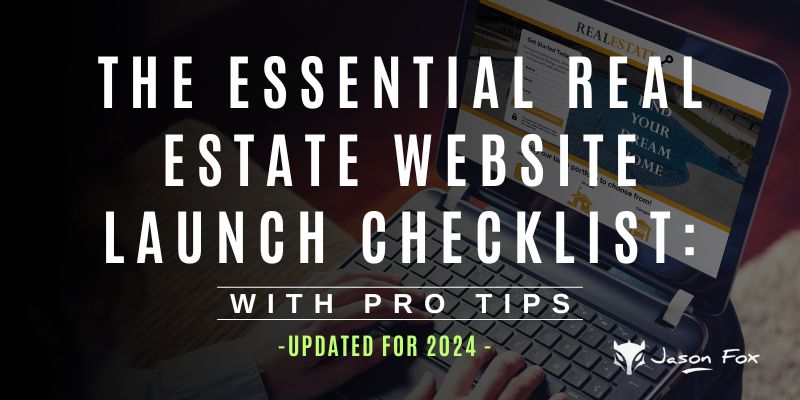THE IMPORTANCE OF A WEBSITE LAUNCH CHECKLIST
Ready to ‘Go Live’ With Your New Real Estate Website? We’ve Got You Covered with Our Complete Launch Checklist. That’s Everything from Testing, to WordPress, and Content.
-Updated for 2023
You’ve put a lot of time into developing your new real estate website and now you are ready to launch. Or are you? Launching your new site isn’t as simple as pushing a button, there are a lot of things to check first. We’ve put it all together in one convenient list so you can be sure you aren’t missing a thing.
In this list we go over the three basic parts of lunching your site, each with their own checklist. In part 1, we focus on testing to make sure your site is functioning as expected. For part 2 we go over the WordPress checklist to make sure you have everything set up correctly. Part 3 covers content. A successful real estate website needs a polished image and comes with certain requirements.
Ready to 'Go Live' With Your New Real Estate Website? We've Got You Covered with Our Complete Launch Checklist. That's Everything from Testing, to WordPress, and Content. Click To TweetTABLE OF CONTENTS
TESTING CHECKLIST
It’s important to make sure your site is functioning as expected. Site speed, technical errors, dead links, and a poor user experience can all affect your site bounce rate.
Content errors:
Make a pass over the entire site. Be on the lookout for spelling errors and temporary or placeholder text. I often use Lorum Ispum text when during the initial design phase.
Pro Tip: There are plenty of great tools to help check your spelling. There is a Chrome plugin called Webpage Spell-Check, and a website called Online-Spellcheck.com.
Images:
Let’s make those images pop without slowing things down. Implement AI-powered image optimization tools like ShortPixel, Smush or Imagify. It’s like giving your website a nitro boost, where images are tailored to fit the viewer’s device, slashing load times and smoothing out their browsing experience. No more waiting around for photos to load, just swift, seamless viewing that keeps potential buyers glued to the screen.
Pro Tip: Convert any PNG files to JPG or WebP. They are smaller file sizes and there is no noticeable difference in quality.
Pro Tip: Use Keep your image optimization between 75% and 90% for best results. Complex images with a lot of colors and details will typically be a larger files size and can be difficult to reduce to a reasonable size.
Page speed:
The top three tools for checking your site speed are GTmetrix, Pingdom, and GoogleSpeed Insights. Site speed is important for a lot of reasons including SEO.
Pro Tip: The tools are great indicators of performance and offer helpful suggestions for speeding up your site. Be careful not to obsess over speed scores, the tools are meant to help find trouble spots.
User experience:
Real estate agents want leads and a good site is built with lead generation in mind. However, if your site is cluttered with CTA’s, sign up forms, links, and other lead generation clutter it can look chaotic. Your customer is there because of a perceived value, so give it to them. Off real content and a smooth clean experience with clear navigation.
Links:
Make a quick pass of the links to make sure everything works as expected. Or, use a tool to check it for you.
Browser Testing:
Make sure the pages display correctly across different browsers. There are a lot of browsers so I would suggest focusing on the ones that have the highest market share.
Pro Tip: No need to test a browser that only has 0.93% of the market share, stick with the top three or four. Currently the top three are Chrome for Android, Chrome 8.5, and Safari for iPhone.
Mobile responsive:
This one is crucial, it is estimates that 76% of home buyers shop for their new house using a mobile device.
Pro-Tip: Chrome has a built in option to check the mobile view. Just open the user console and you’ll see an option at the top to view the browser in mobile view. You can also select devices to emulate from Settings.
Forms:
Test the forms to make sure they are sending and receiving correctly.
Pro Tip: Use a test account to check the forms and keep the testing isolated from the live email accounts.
WORDPRESS CHECKLIST
WordPress is a remarkable tool with lots of options to help with design, SEO, performance, security, etc. You don’t need most of these features at a deep level but you should have a basic understanding of what they do.
In this list we cover all of the WordPress features you need to know to get your real estate website ready to launch.
Check your SEO:
Make sure the Yoast SEO Plugin is installed and setup. The pages should have a unique title, meta description, and keywords.
Now, let’s give your content that extra edge. Incorporate AI-based SEO tools like Clearscope or MarketMuse. These aren’t your everyday tools; they harness AI to dive deep into your content, making sure it speaks the language of both your audience and search engines. They’ll sift through your words, suggest enhancements, and ensure every page and post is primed to rank. Think of them as your SEO coaches, guiding your content to the top of the search results.
Check your permalinks:
Make sure the permalinks are configured in a way that is logical to visitors and benefit Google indexing.
Remove unused plugins, tools, and themes:
Make a pass through your plugins and theme builder tools to see if there are any unnecessary or redundant items. If you’ve installed any plugins to test out and don’t end of using them make sure they get deleted. The same goes for extra themes. Not only do they take up unnecessary space they will require updating regularly, even if they are inactive.
But let’s not stop there. It’s time to bolster your site’s defenses. Enhance your website’s security by integrating AI-driven security plugins such as Wordfence or Sucuri. These aren’t your run-of-the-mill security solutions; they’re powered by machine learning, constantly evolving to outsmart the latest threats. They’re like having a digital security guard that never sleeps, always there to protect your real estate haven from unwanted intruders.
Pro Tip: It’s a good idea to keep a spare inactive theme like ‘Twenty Twenty-Four‘ installed in case you need to deactivate your theme for any reason.
Pro Tip: Some premium themes like Avada and Divi come with lots of great design tools built in. Many of these tools never get used and can potentially affect your site speed. Fortunately you can remove them. Check the list when you are done and take out anything not being used. Avada even comes with a nifty Performance Wizard that walks you through the process in minutes.
Remove unused posts, and pages:
This includes drafts or pages in the trash folder.
Remove unused images:
Scan you media library for duplicate or unused images.
Remove revisions:
Revisions are autosaved by WordPress during development and can potentially slow down your site. The easiest way to clean these up is to use a plugin like WP-Sweep.
Check time-zone:
Make sure the time-zone is set correctly for scheduling updates. Go to Settings > General and look for the Timezone dropdown menu.
Create 404 page:
Add a custom 404 page that will redirect users back to your site should they encounter a broken link. Without it the visitor encounters a dead end and they leave your site.
Add any 301 redirects:
Clean up any page redirections and avoid 404 errors. If you are rebuilding or making significant changes to a site you may need to include a plugin to manage the 301 redirects. A great option for this is a plugin simply called ‘Redirection‘. It’s easy to use and you’ll have it all set up in no time.
Analytics:
If you have Google analytics installed make sure it’s configured correctly and analyzing traffic.
Backup:
Make sure a backup is installed. The better hosts, like WP Engine, include daily backups as part of their service. You can also include backup your site with a utility like Updraft WordPress Backup Plugin.
Check your caching plugins:
We like WP Rocket, it’s super easy to set up and will get your site humming. Check the cache options, file optimization, LazyLoad, and preloading. Make sure your site still looks the way you expect. Using LazyLoad and minifying CSS or JavaScript file in particular can cause problems on the front end.
Pro Tip: Some website hosts, like Siteground, have built in site caching plugins as part of their service. Make sure you don’t have similar plugins that may cause a conflict.
Pro Tip: Use a CDN like Cloudflare. What is a CDN? A CDN, or Content Delivery Network is a geographically distributed network of servers used to distribute a websites images locally, reducing load time. Cloudflare is a popular service with a great free account option that will work fine for most real estate agents. Many premium caching plugins like WP Rocket automatically configure with Cloudflare.
Security:
Website hosts all provide some level of security built in but you can always get more. Top security plugins for 2020 include Sucuri, iThemes Security Pro and Jetpack.
Spam:
You can limit spam by disabling comments, or using the moderate option. With the moderate option you will need to approve any comments before they show up on your site, This is a great way to interact with your customers as well as keep the annoying bots out. Also, be on the lookout for pingbacks and trackbacks. Use a plugin like Askimet to control the spam.
Pro Tip: When moderating comments look for the following: embedded links – in the comment section or the URL field – linking to a suspicious source, the use of keywords in place of a name, broadly worded comments that could apply to any post, and foreign language characters.
SSL certificate:
This is included with all the better hosing services. SSL stands for Secure Layer Socket certificate and it’s used to show your site is secure. The bigger browsers like Chrome will flag you if you don’t have it. If it is included with your hosting service it’s easy to install with the help of Really Simple SSL . If you need help just contact your host.
PRO Tip: If your hosting service charges extra for this certificate you may want to reconsider who you are using since it’s pretty much standard these days.
Turn on Search Engine Indexing:
This should have been turned off while in development. When you are ready to go live go to your WordPress dashboard and select Settings > Reading, check ‘Search Engine Visibility’, and Save Changes.
Create sitemap:
A sitemap provides information about the pages, images, , videos, and other files on your website to search engine crawlers. It gives them a ‘map’ of your site allowing for better site indexing and better SEO. It helps search engines like Google understand you so users can find you. In short, it helps your site get discovered.
WordPress automatically creates a sitemap but you should always check it for unwanted pages. Plugins like Yoast SEO will also do the job for you.
Optimize your robots.txt file:
Google checks your sitemap the first time it gets discovered, and again if notified of a change. The robots.txt file specifies the location of the sitemap. Example: ‘Sitemap: http://example.com/sitemap_location.xml‘.
Update Admin Email:
This is the email used to notify the site administrator of anything going on with the site. It is only necessary to change the email if the person developing the site is different that the person who will be managing it.
Double-check your IDX setup:
Depending on the service you are using you may have an API key. Double check and make sure the correct API key is being used. If you have wrapper pages make sure they are showing the correct header/footer design.
Pro Tip: Double check the background cron to see what intervals it is set for. The ‘cron’ is a software utility schedules intervals for a task, in this case, your real estate listings. Choose an interval that works for you, I usually go with a short interval like three minutes. If for some reason you find this slows your site down you can bump the number a little higher.
Pro Tip: Sometime there are conflicts between IDX services that use wrapper pages and caching plugins. IDX Broker has a great wrapper page option but using a cache plugin can cause problems. For example; If you notice the listings aren’t showing up in the wrapper page simply disable caching for the wrapper page. Caching plugins like WP Rocket offer this option on every page.
Pro Tip: If you are using IDX Broker you should consider creating a CNAME record to point your subdomain address to. IDX Broker lets you customize your subdomain address and it’s easy to do, plus it has added SEO value. Check out our complete guide to ordering and optimizing IDX Broker and adding custom subdomain names.
CONTENT CHECKLIST
Depending on your region, MLS, or Broker there may be specific requirements for your site. If you are developing a single agent or team site you may be subject to your Brokers requirements. Commercial and residential sites may have different disclaimers. Always check with your broker or MLS first.
The following list of items are all visible on your websites front end.
But first, let’s talk content. Want to keep your site’s content as fresh as your listings? Utilize AI-driven content creation tools like Jasper or Writesonic. Picture this: engaging property descriptions and compelling blog posts that practically write themselves, all while keeping SEO in mind. These tools are like having a digital wordsmith at your fingertips, helping you churn out high-quality content that captures attention and keeps your audience coming back for more.
Check your calls-to-action:
Make sure there are enough CTA’s throughout the site to encourage users to sign up but not so much that they get discouraged and leave.
Pro Tip: Visitors are on your site because of it’s perceived value. There in nothing wrong with asking them to contact you but don’t make it the focus of the site. Give them something of value first, then encourage a response.
Logo and Favicon:
Make sure the correct logo images are used throughout the site. Adding a favicon is a nice touch as well. A favicon is little icon displayed in the browser tab. It’s typically designed to look like a simplified version of your logo.
Now, let’s make those images pop without slowing things down. Implement AI-powered image optimization tools like ShortPixel or Imagify. It’s like giving your website a nitro boost, where images are tailored to fit the viewer’s device, slashing load times and smoothing out their browsing experience. No more waiting around for photos to load, just swift, seamless viewing that keeps potential buyers glued to the screen.
Pro Tip: Use Retina versions of your logo to display on higher-resolution screens. Most WordPress themes have an option to include retina versions of the logo. The retina version is 2x the size of the original. It is not necessary of the logo is SVG format.
Pro Tip: Convert any PNG files to JPG or WebP. They are smaller file sizes and there is no noticeable difference in quality.
Pro Tip: Use Keep your image optimization between 75% and 90% for best results. Complex images with a lot of colors and details will typically be a larger files size and can be difficult to reduce to a reasonable size.
Social Links:
Check to make sure the social follow links available on the site and go to the correct accounts. Make sure Social share links are available on relevant pages and articles you want people to share.
Pro Tip: Plugins like Social Warfare are convenient especially if you want to add sharing links sitewide.
Pro Tip: Use Social Share images. Without them sharing your page on social media will look pretty dull. Yoast has it built in.
Legal notices:
Depending on your region, MLS, or Broker, you may need to include a disclaimer , terms and conditions, or privacy policy. Some other examples of legal items you may be required to include: DCMA (Digital Millennium Copyright Act Notice), CBRE (Coldwell Banker Richard Ellis), Equal Housing Opportunity logo, Realtor logo.
These are usually added to the footer. Look familiar?
Other Broker details:
If you are affiliated with a broker make sure all broker specific references are in place. Some brokers require their logo to be a specific size when paired with your own. They may also require certain colors be featured prominently as well as reference pages. Check with your managing broker for details.
Check the IDX listings:
Check any pages where IDX listings are active. Make sure they are displaying the correct listings.
Pro Tip: If you are using a service like our favorite, IDX Broker, the wrapper pages and map pins won’t display until the site goes live.
SUMMARY
Our list is pretty comprehensive and there may be items you can skip. For example, not everyone will include Google analytics tracking.
If you have checked everything and are happy with the design you are ready to launch your new real estate website. Once it’s launched be sure to give it the once over to make sure everything still looks good.







Great information. Thanks!
Very Good information
Thanks for sharing the useful information
Looks as if your spell check tool missed something..
If you are affiliated with a broker make sure “aby” broker specific references are in place. ABY or ANY?
Thanks for the heads up.